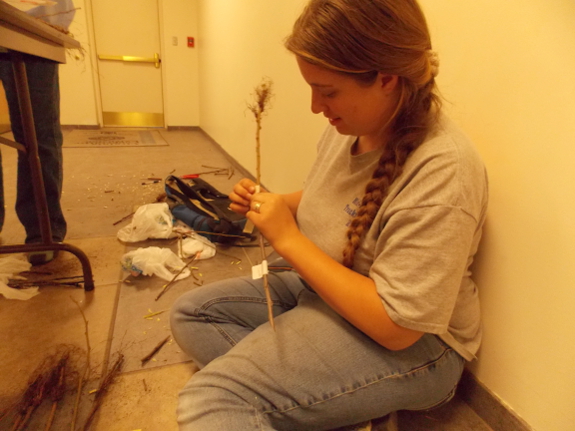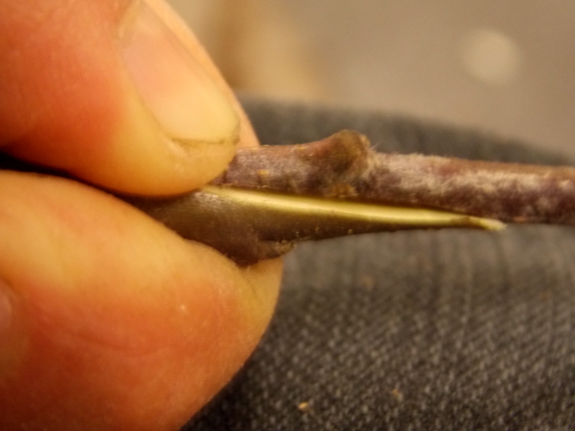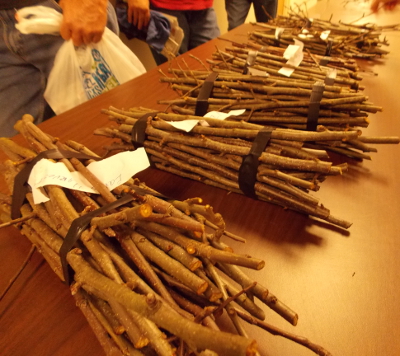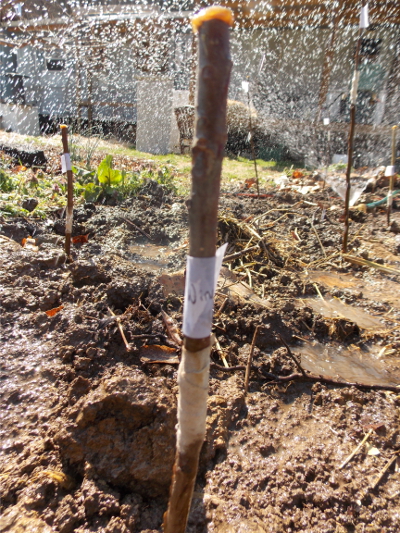
Grafting workshop 2014

When I first walked into our grafting workshop
and saw the selection of scionwood, I was a bit disappointed. The
extension agent had teamed up with a local farmer, who brought in prime
scionwood from his trees in exchange for some free rootstock.
That part was good. The bad part was that the only options were
pretty mainstream: Red Delicious, Yellow Delicious, Granny Smith, Lodi,
Winesap, Stayman Winesap, Wolf River, and Early Harvest. Only
Early Harvest was on my wish list, although I did go ahead and get a Red
Delicious (for Mark), a Winesap (for backup), and a Wolf River (as an
experiment).

But Kayla and I are slow
grafters, so as others left, they offered us the remnants of special
scionwood they'd brought to the class. Much of this scionwood was
so skinny that I had to match only one side of the scionwood to the
rootstock, so it might or might not take. Despite the sub-par
scionwood, though, I couldn't turn down varieties I'd never heard of
like Wood's Favorite (a seedling of Maiden's Blush) and Pound Pippin
(aka Fall Pippin, a popular commercial variety in the nineteenth
century), plus a modern variety  that
Kayla adores (Jonagold) and one that Mark adores (HoneyCrisp). I
also snagged a variety of Winesap that the attendee swore was the "real
old-fashioned Winesap," and I took a gamble on a pear that the owner
told me was an early, red variety, name unknown. (There were a few
pear rootstock available at the workshop --- the pear, of course,
didn't go on apple rootstock.)
that
Kayla adores (Jonagold) and one that Mark adores (HoneyCrisp). I
also snagged a variety of Winesap that the attendee swore was the "real
old-fashioned Winesap," and I took a gamble on a pear that the owner
told me was an early, red variety, name unknown. (There were a few
pear rootstock available at the workshop --- the pear, of course,
didn't go on apple rootstock.)
Some of my gambles will
probably perish. For example, when I came home and looked up
Jonagold, I discovered that the variety is rated as very susceptible to cedar apple rust,
which is our worst apple disease and which I treat only with variety
selection. On the other hand, perhaps I should have taken another
grafter up on his offer of a White Apple, which I thought was just a
vague term but which actually turns out to possibly be a synonym for
Belmont, another rare variety. Even though each unknown type will
take up space and a bit of time, I don't mind gambling on the chance of
getting a truly astounding apple variety or two when these plants start
bearing between 2019 and 2022.
 Back
at home, I soaked the roots of the baby trees overnight to make up for
them sitting out during the workshop, then I made them a good
home. Mark reminded me that every tree that came home from the
first two grafting workshops I attended died from deer nibbling, weed
explosions, and lack of water. Our farm is much more established
now, but I still went a bit overboard on protecting our babies. I
planted them about a foot or so apart in the row where I'd ripped out
cultivated blackberries last fall, within easy hose reach of the trailer
and in soil that's rich and weed-free. After watering the trees
in and mulching them well, I even erected a deer-proof cage out of trellis material and U-posts
just in case those few deer who make it into our homestead every year
make a bee line for the baby apples. Hopefully our new trees will
all survive and thrive!
Back
at home, I soaked the roots of the baby trees overnight to make up for
them sitting out during the workshop, then I made them a good
home. Mark reminded me that every tree that came home from the
first two grafting workshops I attended died from deer nibbling, weed
explosions, and lack of water. Our farm is much more established
now, but I still went a bit overboard on protecting our babies. I
planted them about a foot or so apart in the row where I'd ripped out
cultivated blackberries last fall, within easy hose reach of the trailer
and in soil that's rich and weed-free. After watering the trees
in and mulching them well, I even erected a deer-proof cage out of trellis material and U-posts
just in case those few deer who make it into our homestead every year
make a bee line for the baby apples. Hopefully our new trees will
all survive and thrive!
Want more in-depth information? Browse through our books.
Or explore more posts by date or by subject.
About us: Anna Hess and Mark Hamilton spent over a decade living self-sufficiently in the mountains of Virginia before moving north to start over from scratch in the foothills of Ohio. They've experimented with permaculture, no-till gardening, trailersteading, home-based microbusinesses and much more, writing about their adventures in both blogs and books.
Want to be notified when new comments are posted on this page? Click on the RSS button after you add a comment to subscribe to the comment feed, or simply check the box beside "email replies to me" while writing your comment.

Anna,
We bought a new house in October and last weekend put 2 new apple trees in, a McIntosh and jonathan. Also put in a seedless concord grape. The house hadn't had its landscaping up kept for 2 years, so spent a month clearing overgrowth and readying for the garden.
How difficult is grafting and how would someone go about finding supplies to do it? We wanted to put in 2 peach trees and some raspberries on the property, but resources only go so far financially for this first year.
Thanks for an awesome blog! Dave